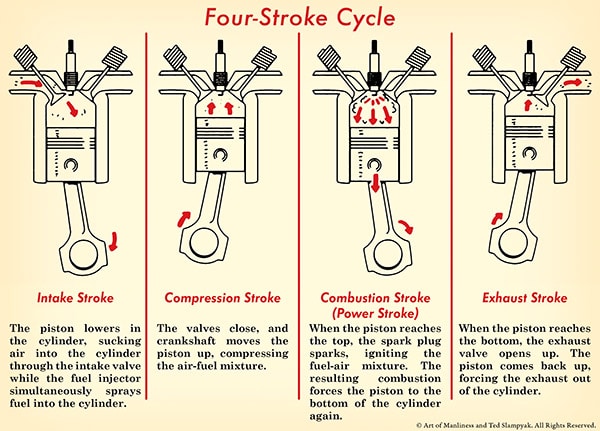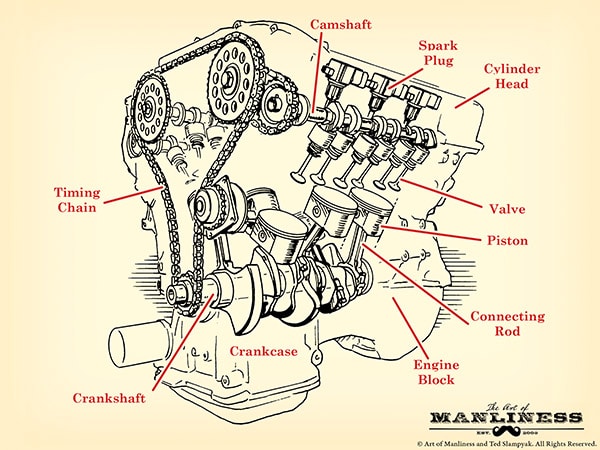The Anatomy of a Car Engine
I’ll show you how the four-stroke engine works here in a bit, but before I do, I thought it would be helpful to go through the various parts of an engine so you’ll have an idea of what’s doing what in the four-stroke process. There is terminology throughout these explanations that relies on other terms in the list, so don’t worry if you get confused at first. Read through the whole thing to get an overall grasp, and then read it again so you have a basic understanding of each piece as it’s being talked about.
Engine Block (Cylinder Block)
The engine block is the foundation of an engine. Most engine blocks are cast from an aluminum alloy, but iron is still used by some manufacturers. The engine block is also referred to as the cylinder block because of the big hole or tubes called cylinders that are cast into the integrated structure. The cylinder is where the engine’s pistons slide up and down. The more cylinders an engine has the more powerful it is. In addition to the cylinders, other ducts and passageways are built into the block that allow for oil and coolant to flow to different parts of the engine.
Combustion Chamber
The combustion chamber in an engine is where the magic happens. It’s where fuel, air, pressure, and electricity come together to create the small explosion that moves the car’s pistons up and down, thus creating the power to move the vehicle. The combustion chamber is made up of the cylinder, piston, and cylinder head. The cylinder acts as the wall of the combustion chamber, the top of the piston acts as the floor of the combustion chamber, and the cylinder head serves as the ceiling of the combustion chamber.
Cylinder Head
The cylinder head is a piece of metal that sits over the engine’s cylinders. There are small, rounded indentations cast into the cylinder head in order to create room at the top of the chamber for combustion. A head gasket seals the joint between the cylinder head and cylinder block. Intake and outtake valves, spark plugs, and fuel injectors (these parts are explained later) are also mounted to the cylinder head.
Piston
Pistons move up and down the cylinder. They look like upside down soup cans. When fuel ignites in the combustion chamber, the force pushes the piston downward, which in turn moves the crankshaft (see below). The piston attaches to the crankshaft via a connecting rod, aka the con rod. It connects to the connecting rod via a piston pin, and the connecting rod connects to the crankshaft via a connecting rod bearing.
On the top of the piston, you’ll find three or four grooves cast into the metal. Inside the grooves piston rings are put in. The piston rings are the part that actually touch the walls of the cylinder. They are made from iron and come in two varieties: compression rings and oil rings. The compression rings are the top rings and they press outward on the walls of the cylinder to provide a strong seal for the combustion chamber. The oil ring is the bottom ring on a piston and it prevents oil from the crankcase from seeping into the combustion chamber. It also wipes excess oil down the cylinder walls and back into the crankcase.
Crankshaft
The crankshaft is what converts the up and down motion of the pistons into a rotational motion that allows the car to move. The crankshaft typically fits lengthwise in the engine block near the bottom. It extends from one end of the engine block to the other. At the front of the end of the engine, the crankshaft connects to rubber belts which connect to the camshaft and delivers power to other parts of the car; at the back end of the engine, the camshaft connects to the drive train, which transfers power to the wheels. At each end of the crankshaft, you’ll find oil seals, or “O-rings,” which prevent oil from leaking out of the engine.
The crankshaft resides in what’s called the crankcase on an engine. The crankcase is located beneath the cylinder block. The crankcase protects the crankshaft and connecting rods from outside objects. The area at the bottom of a crankcase is called the oil pan and that’s where your engine’s oil is stored. Inside the oil pan, you’ll find an oil pump that pumps oil through a filter, and then that oil is squirted on to the crankshaft, connecting rod bearings, and cylinder walls to provide lubrication to the movement of the piston stroke. The oil eventually drips back down into the oil pan, only to begin the process again
Along the crankshaft you’ll find balancing lobes that act as counterweights to balance the crankshaft and prevent engine damage from the wobbling that occurs when the crankshaft spins.
Also along the crankshaft you’ll find the main bearings. The main bearings provide a smooth surface between the crankshaft and engine block for the crankshaft to spin.
Camshaft
The camshaft is the brain of the engine. It works in conjunction with the crankshaft via a timing belt to make sure intake and outtake valves open and close at just the right time for optimal engine performance. The camshaft uses egg-shaped lobes that extend across it to control the timing of the opening and closing of the valves.
Most camshafts extend through the top part of the engine block, directly above the crankshaft. On inline engines, a single camshaft controls both the intake and outtake valves. On V-shaped engines, two separate camshafts are used. One controls the valves on one side of the V and the other controls the valves on the opposite side. Some V-shaped engines (like the one in our illustration) will even have two camshafts per cylinder bank. One camshaft controls one side of valves, and the other camshaft controls the other side.
Timing System
As mentioned above, the camshaft and crankshaft coordinate their movement via a timing belt or chain. The timing chain holds the crankshaft and camshaft in the same relative position to each other at all times during the engine’s operation. If the camshaft and crankshaft become out of sync for whatever reason (the timing chain skips a gear cog, for example), the engine won’t work.
Valve train
The valve train is the mechanical system that’s mounted to the cylinder head that controls the operation of the valves. The valve train consists of valves, rocker arms, push rods, and lifters.
Valves
There are two types of valves: intake valves and outtake valves. Intake valves bring a mixture of air and fuel into the combustion chamber to create the combustion to power the engine. Outtake valves let the exhaust that’s created after the combustion out of the combustion chamber.
Cars typically have one intake valve and one outtake valve per cylinder. Most high-performing cars (Jaguars, Maserati, etc.) have four valves per cylinder (two intake, two outtake). While not considered a “high performance” brand, Honda also uses four valves per cylinder on their vehicles. There are even engines with three valves per cylinder — two inlet valves, one outtake valve. Multi-valve systems allow the car to “breathe” better, which in turn improves engine performance.
Rocker Arms
Rocker arms are little levers that touch the lobes, or cams, on the camshaft. When a lobe lifts one end of the rocker, the other end of the rocker presses down on the valve stem, opening the valve to let air in to the combustion chamber or letting exhaust out. It works sort of like a see-saw.
Fuel Injectors
In order to create the combustion needed to move the pistons, we need fuel in the cylinders. Before the 1980s, cars used carburetors to supply fuel to the combustion chamber. Today, all cars use one of three fuel injection systems: direct fuel injection, ported fuel injection, or throttle body fuel injection.
With direct fuel injection, each cylinder gets its own injector, which sprays fuel directly into the combustion chamber at just the right time to combust.
With ported fuel injection, instead of spraying the fuel directly into the cylinder, it sprays into the intake manifold just outside the valve. When the valve opens, air and fuel enter the combustion chamber.
Throttle body fuel injection systems sort of work how carburetors did, but without the carburetor. Instead of each cylinder getting its own fuel injector, there’s only one fuel injector that goes to a throttle body. The fuel mixes with air in the throttle body and then is dispersed to the cylinders via the intake valves.
Sparkplug
Above each cylinder is a sparkplug. When it sparks, it ignites the compressed fuel and air, causing the mini-explosion that pushes the piston down.
The Four-Stroke Cycle 
So now that we know all the basic parts of the engine, let’s take a look at the movement that actually makes our car move: the four-stroke cycle.
The above illustration shows the four-stroke cycle in a single cylinder. This is going on in the other cylinders as well. Repeat this cycle a thousand times in a minute, and you get a car that moves.

Comments
Post a Comment